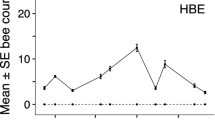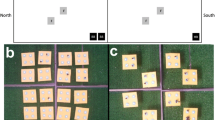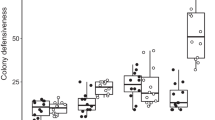Abstract
In this field experiment, we test and support the hypothesis that exploitative competition between bees can influence several aspects of their foraging behaviour. Three treatments of lavender patches were set out: bumble bees excluded, honey bees excluded, control. Bumble bees are known to handle lavender flowers more rapidly than honey bees, partly due to their longer tongues. As predicted, excluding these superior competitors consistently (n = 4 trials) and greatly increased honey bee numbers per patch (14-fold increase; P < 0.001). The exclusion of bumble bee also caused multiple changes to honey bee foraging behaviour: time spent on a patch (+857 %; P < 0.001), flower handling time (+16 %, P = 0.040), interval between probed flowers (−27 %, P = 0.012), proportion of interflower flights (−26 %, P < 0.001) and flowers rejected (−12 %, P < 0.001). Conversely, and also as predicted, excluding honey bees had no effect on bumble bee numbers or foraging behaviour. A key consequence of bumble bee exclusion was to increase the mean flower nectar content from 0.007 to 0.019 μl (+171 %). By constructing an energy budget, we find that this leads to honey bees making a substantial, rather than a marginal, energetic profit per flower visited. Our results show the foraging behaviour of individual bees is extremely flexible and greatly influenced by the effects of interspecific competition on nectar rewards. Collectively, these individual decisions can have rapid and important consequences at the community level, including competitive exclusion.



Similar content being viewed by others
References
Balfour NJ, Garbuzov M, Ratnieks FLW (2013) Longer tongues and swifter handling: why do more bumble bees (Bombus spp.) than honey bees (Apis mellifera) forage on lavender (Lavandula spp.)? Ecol Entomol 38:323–329
Biesmeijer JC, Slaa EJ (2006) The structure of eusocial bee assemblages in Brazil. Apidologie 37:240–258
Brian AD (1957) Differences in the flowers visited by four species of bumble-bees and their causes. J Anim Ecol 26:71–98
Brittain C, Williams N, Kremen C, Klein AM (2013) Synergistic effects of non-Apis bees and honey bees for pollination services. P Roy Soc B 280:201–208
Crawley MJ (2014) Statistics: an introduction using R. Wiley, New Jersey
Diamond JM (1970) Ecological consequences of island colonization by southwest Pacific birds, I. Types of niche shifts. P Roy Soc B 67:529–536
Eccard JA, Ylönen H (2002) Direct interference or indirect exploitation? An experimental study of fitness costs of interspecific competition in voles. Oikos 99:580–590
Free JB (1965) The allocation of duties among worker honeybees. Symp Zool Soc Lond 22:39–59
Free JB (1968) Dandelion as a competitor to fruit trees for bee visits. J Appl Ecol 5:69–178
Garbuzov M, Ratnieks FLW (2013) Quantifying variation among garden plants in attractiveness to bees and other flower‐visiting insects. Funct Ecol 28:364–374
Goulson D, Sparrow KR (2009) Evidence for competition between honeybees and bumblebees; effects on bumblebee worker size. J Insect Conserv 13:177–181
Goulson D, Lye GC, Darvill B (2008) Decline and conservation of bumble bees. Ann Rev Entomol 53:191–208
Greenleaf SS, Kremen C (2006) Wild bees enhance honey bees’ pollination of hybrid sunflower. Proc Natl Acad Sci 103:13890–13895
Harder LD (1983) Flower handling efficiency of bumble bees: morphological aspects of probing time. Oecologia 57:274–280
Hart D (1987) Feeding territoriality in aquatic insects: cost-benefit models and experimental tests. Am Zool 27:371–386
Heinrich B (1976) Resource partitioning among some eusocial insects: bumblebees. Ecology 57:874–889
Heinrich B (1979) Bumblebees economics. Harvard University Press, London
Herrera CM (1989) Pollinator abundance, morphology, and flower visitation rate: analysis of the “quantity” component in a plant-pollinator system. Oecologia 80:241–248
Herrera CM (1990) Daily patterns of pollinator activity, differential pollinating effectiveness, and floral resource availability, in a summer-flowering Mediterranean shrub. Oikos 58:277–288
Inouye DW (1978) Resource partitioning in bumble bees: experimental studies of foraging behaviour. Ecology 59:672–678
Ishii HS, Kadoya T, Kikuchi R, Suda SI, Washitani I (2008) Habitat and flower resource partitioning by an exotic and three native bumble bees in central Hokkaido, Japan. Biol Conserv 141:2597–2607
Kevan PG, Baker HG (1983) Insects as flower visitors and pollinators. Ann Rev Entomol 28:407–453
Lister BC (1976) The nature of niche expansion in West Indian Anolis lizards II: evolutionary components. Evolution 30:677–692
Moreno RS, Kays RW, Samudio R Jr (2006) Competitive release in diets of ocelot (Leopardus pardalis) and puma (Puma concolor) after jaguar (Panthera onca) decline. J Mammal 87:808–816
Paini DR (2004) Impact of the introduced honey bee (Apis mellifera)(Hymenoptera: Apidae) on native bees: a review. Austral Ecol 29:399–407
Persson L (1985) Asymmetrical competition: are larger animals competitively superior? Am Nat 126:261–266
Persson A, Hansson LA (1999) Diet shift in fish following competitive release. Can J Fish Aquat Sci 56:70–78
Potts SG, Biesmeijer JC, Kremen C, Neumann P, Schweiger O, Kunin WE (2010) Global pollinator declines: trends, impacts and drivers. Trends Ecol Evol 25:345–353
Reitz SR, Trumble JT (2002) Competitive displacement among insects and arachnids. Ann Rev Entomol 47:435–465
Ribbands CR (1949) The foraging method of individual honey-bees. J Anim Ecol 18:47–66
R-Project (2012) R: A language and environment for statistical computing. R Foundation, Vienna, Austria. URL http://www.r-project.org/. Accessed 10 April 2015
Schaffer WM, Jensen DB, Hobbs DE, Gurevitch J, Todd JR, Schaffer MV (1979) Competition, foraging energetics, and the cost of sociality in three species of bees. Ecology 60:976–987
Schoener TW (1983) Field experiments on interspecific competition. Am Nat 122:240–285
Seeley TD (1995) The wisdom of the hive. Harvard University Press, London
Segers FHID, Taborsky B (2012) Competition level determines compensatory growth abilities. Behav Ecol 23:665–671
Severinghaus LL, Kurtak BH, Eickwort GC (1981) The reproductive behaviour of Anthidium manicatum (Hymenoptera: Megachilidae) and the significance of size for territorial males. Behav Ecol Soc Biol 9:51–58
Simberloff D, Schmitz DC, Brown TC (1997) Strangers in paradise: impact and management of non-indigenous species in Florida. Island Press, Washington D.C
Stephens DW, Krebs JR (1986) Foraging theory. Princeton University Press, Princeton
Streamclip (2014) MPEG Streamclip for Mac and Windows. http://www.squared5.com/. Accessed 10 April 2015
Thomson D (2004) Competitive interactions between the invasive European honey bee and native bumble bees. Ecology 85:458–470
Upson T, Andrews S (2004) The genus Lavandula. Timber Press, Portland
Van Valen L (1965) Morphological variation and width of ecological niche. Am Nat 99:377–390
Ward DM, Nislow KH, Armstrong JD, Einum S, Folt CL (2007) Is the shape of the density-growth relationship for stream salmonids evidence for exploitative rather than interference competition? J Anim Ecol 76:135–138
Wetherwax PB (1986) Why do honeybees reject certain flowers? Oecologia 69:567–570
Williams CS (1998) The identity of the previous visitor influences flower rejection by nectar-collecting bees. Anim Behav 56:673–681
Acknowledgments
We thank Felix Schrell, Mihail Garbuzov, Katie Fensome, Liz Samuelson, Martyn Stenning, Charles Fox, Jim Balfour, Julia Balfour and several anonymous referees for their helpful comments. NB’s PhD is funded by Waitrose Limited and the C B Dennis British Beekeepers’ Research Trust.
Funding
This study was funded by Waitrose Ltd and the C B Dennis British Beekeepers’ Research Trust.
Conflict of interest
The authors declare that they have no competing interests.
Ethical approval
All applicable international, national and/or institutional guidelines for the care and use of animals were followed.
Author information
Authors and Affiliations
Corresponding author
Additional information
Communicated by W. T. Wcislo
Electronic supplementary material
Below is the link to the electronic supplementary material.
ESM 1
(DOCX 165 kb)
Rights and permissions
About this article
Cite this article
Balfour, N.J., Gandy, S. & Ratnieks, F.L.W. Exploitative competition alters bee foraging and flower choice. Behav Ecol Sociobiol 69, 1731–1738 (2015). https://doi.org/10.1007/s00265-015-1985-y
Received:
Revised:
Accepted:
Published:
Issue Date:
DOI: https://doi.org/10.1007/s00265-015-1985-y




